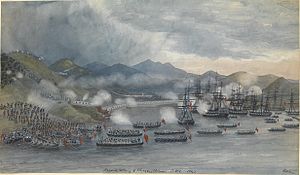Capture of Chusan (1841)
This article relies largely or entirely on a single source. (June 2021) |
| Second Capture of Chusan | |||||||
|---|---|---|---|---|---|---|---|
| Part of the First Opium War | |||||||
 Second taking of Chusan | |||||||
| |||||||
| Belligerents | |||||||
|
| |||||||
| Commanders and leaders | |||||||
|
Hugh Gough William Parker | Ge Yunfei (KIA)[1] | ||||||
| Strength | |||||||
|
13 ships[2] 2,607 troops[3] | Unknown | ||||||
| Casualties and losses | |||||||
|
2 killed[3] 27 wounded[3] |
1,500 casualties[4] 136 guns captured[5] | ||||||
The second capture of Chusan (Chinese: 第二次定海之戰) occurred on 1 October 1841 during the First Opium War when British forces captured the city of Dinghai, capital of the Chusan (Zhoushan) islands off the east Chinese coast.
The fortified city of Dinghai, with a population of 30,000, was defended by the Chinese under the command of Keo. After a brief one-sided seaborne operation involving the 55th Foot, the city fell to the far superior British forces which captured 100 iron guns, 36 brass cannon, and 540 gingalls (heavy muskets or light guns mounted on swivels) for the loss of 2 British killed and 28 wounded.[6][7]
Gallery[edit]
-
Map of the capture
-
Attack on the heights of Chusan
Notes[edit]
- ^ MacPherson 1843, p. 216
- ^ MacPherson 1843, pp. 358–359
- ^ a b c MacPherson 1843, p. 374
- ^ MacPherson 1843, p. 217
- ^ MacPherson 1843, p. 375
- ^ China, in a Series of Views, Displaying the Scenery, Architecture ..., Volume 1. p. 92.
- ^ The British Empire, Army Campaigns, Tinghai, September 1841 http://www.britishempire.co.uk/forces/armycampaigns/asia/china/opiumwar.htm
References[edit]
- MacPherson, Duncan (1843). Two Years in China (2nd ed.). London: Saunders and Otley
Further reading[edit]
- Murray, Alexander (1843). Doings in China. London: Richard Bentley. pp. 23–42.


